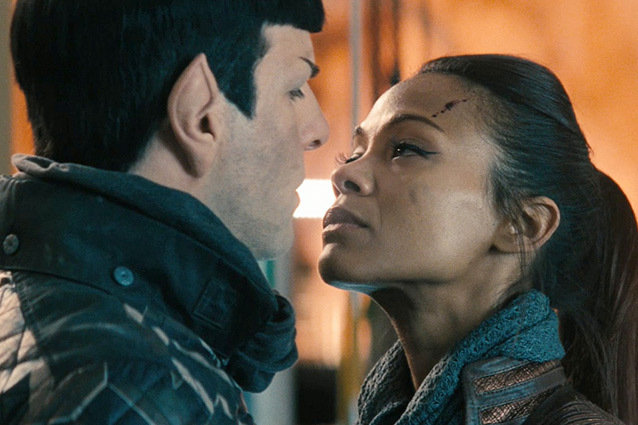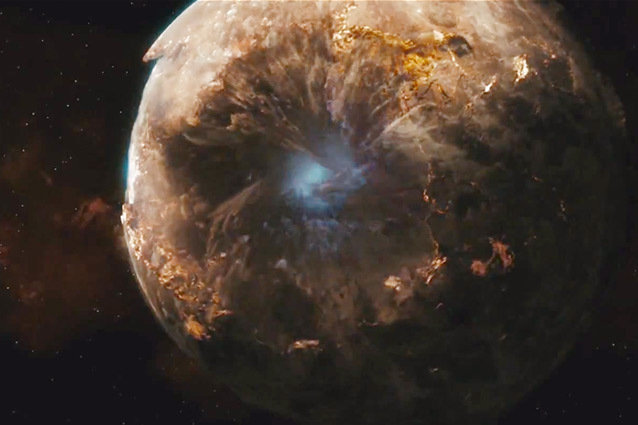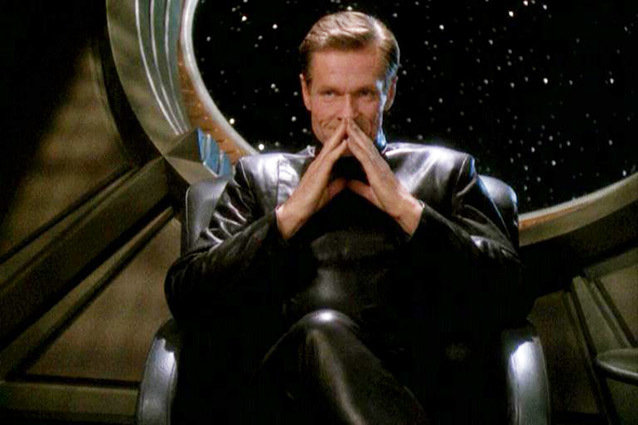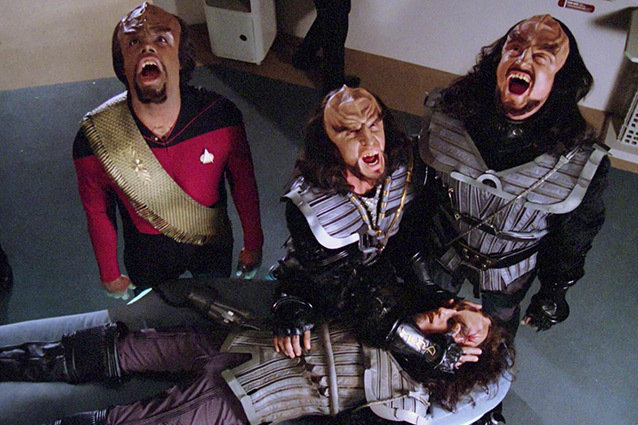
Paramount Pictures
It's been four long years since J.J. Abrams rebooted Star Trek with an origin story for the ages: how Kirk, Spock, and the rest of the crew of the USS Enterprise
NCC-1701 first came together. Now if you're a diehard Trekker who's
watched the movie multiple times you probably need no catching up for
Abrams' sequel, Star Trek Into Darkness, opening May 17. For you non-nerds, though, you may need a refresher course. Here are 8 things you need to know before you see Star Trek Into Darkness.1. Spock and Uhura Are In a Relationship — One of the most surprising things about the 2009 Star Trek was how we learned that Spock's (Zachary Quinto) green blood runs hot for communications officer Uhura (Zoe Saldana). That was certainly never a part of The Original Series or its spin-off films. That's because Abrams didn't just make a prequel with his Star Trek, he and writers Roberto Orci and Alex Kurtzman introduced a time-travel element where a disgruntled Romulan freighter captain named Nero traveled back in time to avenge himself on Spock for allowing his homeworld of Romulus to be destroyed in a supernova. That simple act of time-travel created a whole new timeline, in which many things have happened that never happened to our characters on The Original Series. Because Nero traveled back to the early 23rd century, Kirk's father, George, was killed; the Federation made face-to-face contact with Romulans some thirty years earlier than in the original timeline; and Spock and Uhura ended up playing tonsil-hockey.
Fans now refer to the original timeline of The Original Series and its subsequent films as "The Prime Timeline." That's where Nero never traveled back in time, George Kirk wasn't killed, the Federation and the Romulans didn't meet face to face until "Balance of Terror," and Uhura and Spock were colleagues but never lovers. However, elements of the new timeline, including Spock and Uhura's sparks, are arguably there in subtler ways in the Prime Timeline. In the Original Series episode "Charlie X," there is some definite sexual tension between Leonard Nimoy's Spock and Nichelle Nichols' Uhura as he plays the lyre and she sings a song about "the handsome man who looks like Satan" — meaning him. Uhura bats her lashes and sends him about every come-hither glance imaginable during their duet, and Spock even smiles! So basically, the concept of the new timeline is that we're seeing the things, such as Spock and Uhura's relationship, that could have happened given these few tweaks to history. When Nero goes back in time and changes history, Spock and Uhura go from having a charged musical recital to a full-blown relationship.
2. The Prime Directive — This wasn't such a big deal in the first movie, but it's critical to keep in mind for Star Trek Into Darkness. Though Starfleet is a military organization, it's one geared toward exploration, discovery, and diplomacy more than warfare. The central guiding principal of Starfleet when encountering other lifeforms is the Prime Directive, which states that Starfleet must not interfere in the natural evolution of alien races that are less technologically advanced. Technically, that means a Federation captain and his crew shouldn't even do anything to alleviate the suffering of aliens less developed. It's a total hands-off, non-interference policy, and it's one that we essentially borrowed from the Vulcans. Our pointy-eared friends only made first contact with humans after we developed warp drive in the year 2063. Only then were we developed enough to be aware of the existence of alien races and embark upon a path toward becoming a part of the interstellar community...or so the Vulcans though. Which is too bad, because we really could have used their help during the dire early part of the 21st century when humanity was engulfed in World War III. (Yeah, the next few decades are really gonna suck.) But the Vulcans felt that not interfering in our natural evolution was more important than alleviating our tremendous hardship. Each race has to grow up by itself. This is very important to the opening of Star Trek Into Darkness.
3. Vulcan Was Destroyed — The most pivotal change to the timeline with Nero's temporal incursion was, of course, the destruction of Vulcan. Nero wanted revenge against Spock for the destruction of Romulus and he got that satisfaction by destroying Spock's world in kind. This alone changes the entire course of Federation history. And it sets up a new conflict within the ranks of Starfleet. We already said that it was a military organization devoted more to exploration and diplomacy than war. After Vulcan, a founding world of the Federation, is destroyed, you better believe that there are those in Starfleet who start to question their mission, who start to think that achieving a security state is more important than seeking out new life forms and new civilizations.

Paramount Pictures
4. Kirk's Command Was Just a Battlefield Promotion — Kirk only got the Captain's Chair in 2009's Star Trek
because Spock had to be relieved after being emotionally compromised
following the destruction of his homeworld. And Spock only got the Enterprise after Nero kidnapped the ship's real captain, Christopher Pike (Bruce Greenwood). Basically, that meant the Enterprise
was Christopher Pike's to have back whenever he wanted...except Pike
was promoted to admiral, meaning he'd most likely assume a desk job
rather than go hopping about the cosmos. That isn't a given, though.
William Shatner's Kirk basically pulls a Leno in Star Trek: The Motion Picture by giving up the Enterprise
to become an admiral, then wanting to assume command of it again,
putting its new captain, Stephen Collins' Will Decker, out of a job.
Something similar happens in Star Trek Into Darkness.
Paramount Television
5. Section 31 — This is something that writers
Roberto Orci and Alex Kurtzman obviously just threw in for the diehard
fans. It's revealed in a throwaway line of dialogue in Star Trek Into Darkness
that one of the major characters is a member of Section 31, a
super-secret intel organization within the Federation that responds to
threats against the Federation while being completely off-the-grid.
Meaning: no accountability. Section 31 first appeared in Star Trek: Deep Space Nine, when the organization was led by Sloan (Iron Man 3's
William Sadler). On that show, we saw that Section 31 had no qualms
about doing things to protect the Federation that completely trampled
its values. They were okay with torture, with biological warfare, and,
interestingly enough, they were very keen to recruit someone who had
been genetically-engineered to have a "superior" intellect and physical
abilities. In that case, the recruit was Dr. Julian Bashir (Alexander
Siddig). Now we realize that Deep Space Nine is set in the 24th century, but 200 years earlier, during the events of the 22nd-century-set Star Trek: Enterprise Section 31 was puttering around even then. You don't need to know anything about Section 31 to appreciate Star Trek Into Darkness,
but that clandestine organization is pretty much the embodiment of the
war for the Federation's soul and whether Starfleet will indeed "boldly
go where no man has gone before" or merely retrench behind their own
borders and build up their defenses.6. Transwarp Beaming — This is one thing that only appears in Abrams' alternate timeline. Apparently, Nero's incursion set in motion events that would inspire Simon Pegg's Scotty to invent something James Doohan's Scotty never thought of: the ability to beam people and objects long-distance, from planet to planet or solar system to solar system. It's technology called "transwarp beaming" and theoretically it means you could transport instantly from Earth to, say, Andoria, a planet in a completely different solar system. Very handy if you're a criminal on the run, like Benedict Cumberbatch's John Harrison. By our reckoning, this technology had only become viable in the original timeline by the late 24th century (as seen in Deep Space Nine and Star Trek: Nemesis) and even then required the person transporting to wear a homing beacon.

Paramount Television
7. The Klingons — The Klingons are, now and forever, humanity's prime antagonists in Star Trek.
They are the embodiment of the bloodlust, the warmongering, the
death-as-sport mentality that humanity once embraced but thankfully
outgrew. All through The Original Series and its related
movies, the Klingons are major villains when it comes to their dealings
with James T. Kirk and crew. These warriors are the fiery yang to the
Romulans' icy, calculating yin. But then something amazing happened. In
the 24th century, a detente began to form between the Klingons and the
Federation, eventually even an alliance, and shows like The Next Generation, Deep Space Nine, and Voyager tried to depict them as noble warriors rather than hot-headed killers.That is not the way the Klingons are presented in Star Trek Into Darkness. Here they are bloodthirsty savages, because it's the 23rd century, which means it's basically the Wild West. They were affected by the altered timeline too. In fact, they captured Nero and held him prisoner for some years while they studied his freighter, the Narada. Alias' Victor Garber had been cast to play Nero's Klingon interrogator. The deleted scene of Garber in costume exists on the Star Trek DVD, but they were otherwise cast out of that movie. They are a big deal in Star Trek Into Darkness, though, and some within the Federation begin to feel that war with the Klingons is inevitable.
8. Carol Marcus — William Shatner's Capt. Kirk cuddled a lot of space babes in his day, but there's only one with whom he actually had a son: Carol Marcus. She was a scientist who specialized in biotechnology, and she'd one day help create the Genesis device that could terraform an entire world in a matter of hours — a device Ricardo Montalban's Khan Noonien Singh saw as a weapon to be exploited. Before Kirk ever began his five-year voyage they had a relationship, and from that relationship emerged their son David. Kirk wanted to take to the stars, though, and Carol wanted to raise her son far away from danger, so they split up, and Kirk became an absentee dad. When he sees David all grown up in The Wrath of Khan, he basically is seeing him for the first time in decades. David, however, is a whiny shell of a man compared to his father. Here's hoping he's been erased from history altogether in the altered timeline.
No comments:
Post a Comment